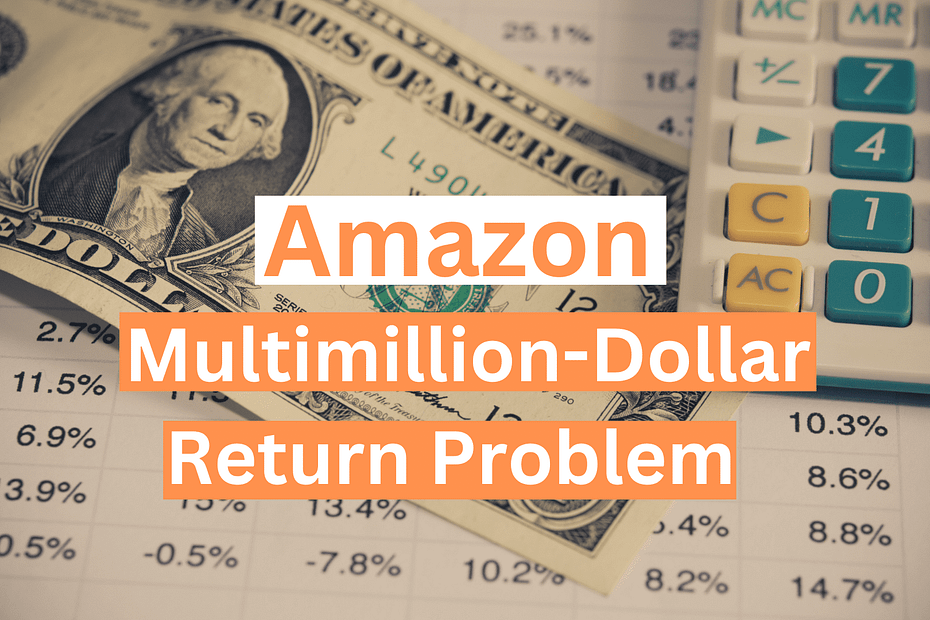Last Updated on: 29th March 2023, 10:27 pm
Amazon has become one of the most popular online shopping platforms in the world, offering a wide range of products at competitive prices.
It also faces a major issue with product returns, which has cost the company millions of dollars in losses.
To address this issue, Amazon needs to understand the root causes of the problem and find effective ways to minimize returns.
See also: Amazon Donkey Meat Selling Problem
Understanding the Multimillion-Dollar Return Problem at Amazon
Amazon’s multimillion-dollar return problem refers to the high rate of returns on products purchased through the platform.
According to recent reports, Amazon’s return rate can be as high as 30%, which is significantly higher than the industry average. This high return rate not only affects Amazon’s revenue but also impacts the environment and the supply chain.
Common Causes of Returns at Amazon
The main reasons for product returns on Amazon include the following:
Product descriptions and images: Customers may return a product if it does not match the product description or images provided on the website.
Shipping and handling issues: Products may get damaged during transit or mishandled during the delivery process, leading to returns.
Quality control issues: Products may have quality issues that were not detected during the manufacturing or inspection process, leading to returns.
Challenges Faced by Amazon in Handling Returns
Amazon faces several challenges in handling product returns, including:
Logistics and inventory management: Managing the logistics of product returns can be complex and costly for Amazon.
Product reselling: Reselling returned products can be challenging, as some items may be damaged, outdated, or unsellable.
Customer satisfaction: Unsatisfied customers may leave negative reviews, impacting Amazon’s reputation.
Suggestions for Fixing the Multimillion Dollar Return Problem at Amazon
To reduce the rate of returns, Amazon can consider the following solutions:
Improving Product Descriptions and Images: Amazon should ensure that product descriptions and images accurately reflect the product being sold. This can help reduce the number of returns due to customer confusion.
Streamlining the Returns Process: Amazon can simplify the returns process by making it more user-friendly and intuitive. This can help reduce the time and effort required to process returns.
Increasing Customer Support and Engagement: Amazon can improve customer support and engagement to address any concerns or issues that customers may have. This can help reduce the number of returns due to customer dissatisfaction.
Implementing Better Quality Control Measures: Amazon can implement better quality control measures to ensure that products meet the required standards before being sold. This can help reduce the number of returns due to product defects.
Providing Better Compensation for Sellers: Amazon can provide better compensation to sellers for items that are returned due to issues beyond their control. This can help incentivize sellers to improve the quality of their products and reduce the rate of returns.
Benefits of Addressing the Return Problem at Amazon
Addressing the return problem at Amazon can have several benefits, including:
Scalability and Flexibility: By reducing the rate of returns, Amazon can scale its operations and expand into new markets with greater ease.
Cost-Effective: By minimizing the number of returns, Amazon can reduce the associated costs of logistics, reselling, and customer support.
Increased Security and Reliability: Addressing the return problem can help improve Amazon’s reputation and reliability, thereby increasing customer trust and loyalty.
Conclusion: The Importance of Addressing the Return Problem at Amazon
The multimillion dollar return problem at Amazon can have significant implications for the company’s revenue, reputation, and environment. By understanding the root causes of returns and implementing effective solutions, Amazon can improve its profitability, reduce its environmental impact, and enhance customer satisfaction.
Addressing the return problem can also help Amazon stay ahead of its competitors in the increasingly competitive e-commerce market.
As more and more customers demand seamless online shopping experiences, minimizing returns is becoming more critical than ever before.
By addressing this problem proactively, Amazon can differentiate itself from its competitors and stay ahead of the curve.
Conclusion
Amazon must take proactive steps to address its multimillion-dollar return problem. By improving product descriptions and images, streamlining the returns process, increasing customer support and engagement, implementing better quality control measures, and providing better compensation to sellers, Amazon can minimize its return rate and reap the benefits of increased scalability, cost-effectiveness, and customer trust.
As e-commerce continues to grow, addressing the return problem has become a crucial factor in determining the success of online retailers like Amazon.



